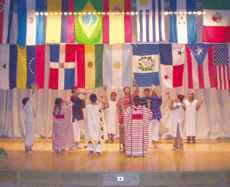Going For Baroque
November 6, 2002
Recently, the Harbor Art Gallery has hosted any number of arts-related events. Whether it’s Wendy Baring-Gould giving lectures about Arts on the Point or the newest artist to display their work there, the Gallery has not lacked for interesting and enticing cultural events. Which brings me to the latest performance, comprised of a selected group of pieces originating from the Baroque period, played by faculty member Mary Oleskiewicz (Baroque flute), with assistance from David Schulenberg (harpsichord) and Susanna Cortesio (Baroque violin).
“Sounds of a Royal Flute” brought to the audience the works of Johann Joachim Quantz’s Sonata in B minor for flute and basso continuo’s first three movements and the first four movements of his Sonata in G minor for flute, violin, and basso continuo, as well as C.P.E. Bach’s first three movements of his Sonata in A minor for flute alone, and two movements of his Sonata in G major for flute and basso continuo.
Oleskiewicz is an authority on Baroque music with a doctorate in musicology from Duke University, a master’s in early music performance practice from Case Western Reserve University, and a Bachelor of Music in Performance from Youngstown State University. As of Fall 2001, she has been teaching music history at UMass Boston. Besides her many degrees, she has received awards such as first prize for National Flute Association’s 2001 triennial Baroque Flutist Artist Competition.
Schulenberg is a faculty member and chair of the music department at Wagner College, besides having published books on music history called The Keyboard Music of J.S. Bach and Music of the Baroque. He has taught at Columbia and Notre Dame as well as performing internationally on the harpsichord and other keyboard instruments.
Not only does Susan Cortesio teach at Longy School of Music and Winchester Community Music School but she has also completed a rural residency in Kentucky, funded in part by the National Endowment for the Arts, and the New Performing Arts Association. She has performed as solo violinist with various ensembles including most recently, the Las Vegas Festival Orchestra and Boston Virtuosi, and has performed as a solo violinist for the show, “I Love You, You’re Perfect, Now Change”.
Since I was unfamiliar with music from the Baroque period, I wasn’t exactly sure what to expect. The aural pleasure I came away with nearly lulled me into a coma from complete relaxation, allowing many in the room to release the collective stress most of us had been under from the weight of midterms.
The term “baroque” is a corrupted form of the Italian word “barocco,” meaning “bizarre” originating in the seventeenth or eighteenth century. The period was characterized by elaborate architecture of church and public buildings. However, the music typically involved stringed instruments, harpsichords, and organs. The music was an attempt at exploring and reflecting the order and structure as well as the beauty that can be found in the universe. Notable examples of Baroque composers were Carl Phillipp Emanuel Bach, Vivaldi, and Handel.
Quantz and Bach were both eighteenth century German composers serving at the court of Frederick the Great of Prussia. Quantz was a talented flutist as well as a composer, tutor, and flute maker to Frederick II. C.P.E. Bach, son of Johann Sebastian Bach, was a keyboard accompanist and famous composer in his own right.
Too often, classical performances can become monotonous for the uneducated listener as the continual striving for technical perfection can cause the player to stand stiff and emotionless, so intent on an immaculate performance are they. Yet Oleskiewicz, Schulenberg, and Cortesio all subtly rock and sway with the shifting and falling tides within the melodies of the music. With the movement of the musicians’ bodies came the visual and auditory involvement of those watching.
Though occasionally hard to follow, it is easy to be carried away in the exploration of form and function of Baroque music in the hands of gifted musicians. Hopefully, there will be more performances like this in the future.





















































